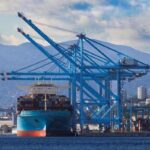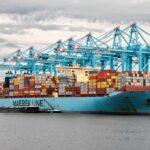Maersk closing north-south transits through Panama Canal

Maersk plans to eliminate Panama Canal vessel transits on a north-south service between Oceania and the U.S. East Coast, citing the ongoing drought that has reduced ship transits and container carrying capacity through the waterway, Journal of Commerce reports.
The Copenhagen-based carrier said Wednesday that its OC1 service linking Australia and New Zealand with the ports of Philadelphia and Charleston will instead use a 50-mile rail service across the Isthmus of Panama to handle cargo between the Atlantic and Pacific.
As a result, the OC1 service will be broken into two loops, Maersk said. The Pacific loop will drop off northbound cargo at Balboa for the land bridge service via rail to Manzanillo, where the Atlantic loop will retrieve the cargo and resume waterborne service.
The carrier did not say whether the nearly 26-day transit time from New Zealand to Philadelphia would change due to the land bridge. It said that while northbound cargo will not be delayed, southbound cargo may see some delays.
Other Maersk services from Asia to the US East Coast will continue to use the Panama Canal.
Along with the Panama Canal, Maersk said the OC1 would omit Cartagena, Colombia, as a call. It also directed shippers to the option of its PANZ service between Oceania and the US West Coast.
Maersk said the decision to omit the Panama Canal crossing on OC1 was “based on current and projected water levels in Gatun Lake,” which provides the water to raise and lower vessels in the canal’s locks. As of Wednesday, the Panama Canal Authority (ACP) said Gatun Lake was at 81.6 feet, compared with a five-year average water level for January of 86.9 feet.
Low water levels have forced the ACP to only allow 24 ships of any size to transit the Canal daily, down from the 35 to 40 ships it could handle before the ongoing drought that has reduced Gatun’s water levels. Ships must also carry less cargo as the Canal is limiting the maximum depth of neo-Panamax vessels to 44 feet from 50 feet. Smaller Panamax vessels, such as the ones in the OC1 service, are restricted to a 39.5-foot depth versus the typical 45 feet.
In early December, ocean carriers in THE Alliance said they were preparing to divert east-west vessel services from the Panama Canal due to the potential for transits being reduced to as few as 18 by February. But with better-than-projected water levels on Gatun Lake, the ACP did not implement that further reduction.










































